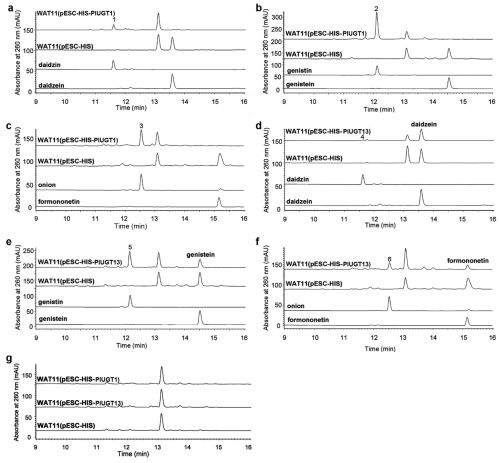
A Novel 7-O-glucosyltransferase Isolated from P. lobata
Apr 15, 2014 Email"> PrintText Size

Glycosides are natural perssades
Pueraria lobata roots have been ascribed a number of pharmacological properties, including hypolipidemic and hypertension effects, anti-tumor activities, preventing osteoporosis and other medicinal effects. Most pharmacological activities of P. lobata extracts are due to the presence of isoflavone O-glycosides, such as daidzin, genistin and ononin. The glucosyltransferase gene isolated from P. lobata holds a potential in the process of either synthesizing novel drugs or glycosylating the existing medicinal compounds.
To investigate the isoflavone metabolism in P. lobata, a research team led by Prof. ZHANG Yansheng at Wuhan Botanical Garden isolated seven full-length UGT candidates with preferential expression in roots. Functional assays in yeast revealed that PlUGT1 (official UGT designation UGT88E12), efficiently glycosylated isoflavone aglycones at the 7-hydroxy group. Recombinant PlUGT1 purified from Escherichia coli cells was shown to be relatively specific for isoflavone aglycones, while flavonoid substrates were poorly accepted. The biochemical results suggested that PlUGT1 was an isoflavone 7-O-glucosyltransferase. The transcript abundance of PlUGT1 was correlated with the accumulation pattern of isoflavone glycosides such as daidzin in P. lobata plants or in cell suspension culture. The biochemical properties and gene expression profile supported the idea that PlUGT1 could play a role in isoflavone glycosylation in P. lobata.
This project was partially supported by the National Natural Science Foundation of China, the Grant for One Hundred Talents Program of the Chinese Academy of Sciences, China and the Innovation Project of Chinese Academy of Science. Relevant results were published in Plant Cell Reports online entitled “Molecular cloning and characterization of an isoflavone 7-O-glucosyltransferase from Pueraria lobata”.

Functional characterization of glucosyltransferases in yeast (Image by WBG)
Glycosides are natural perssades
Pueraria lobata roots have been ascribed a number of pharmacological properties, including hypolipidemic and hypertension effects, anti-tumor activities, preventing osteoporosis and other medicinal effects. Most pharmacological activities of P. lobata extracts are due to the presence of isoflavone O-glycosides, such as daidzin, genistin and ononin. The glucosyltransferase gene isolated from P. lobata holds a potential in the process of either synthesizing novel drugs or glycosylating the existing medicinal compounds.
To investigate the isoflavone metabolism in P. lobata, a research team led by Prof. ZHANG Yansheng at Wuhan Botanical Garden isolated seven full-length UGT candidates with preferential expression in roots. Functional assays in yeast revealed that PlUGT1 (official UGT designation UGT88E12), efficiently glycosylated isoflavone aglycones at the 7-hydroxy group. Recombinant PlUGT1 purified from Escherichia coli cells was shown to be relatively specific for isoflavone aglycones, while flavonoid substrates were poorly accepted. The biochemical results suggested that PlUGT1 was an isoflavone 7-O-glucosyltransferase. The transcript abundance of PlUGT1 was correlated with the accumulation pattern of isoflavone glycosides such as daidzin in P. lobata plants or in cell suspension culture. The biochemical properties and gene expression profile supported the idea that PlUGT1 could play a role in isoflavone glycosylation in P. lobata.
This project was partially supported by the National Natural Science Foundation of China, the Grant for One Hundred Talents Program of the Chinese Academy of Sciences, China and the Innovation Project of Chinese Academy of Science. Relevant results were published in Plant Cell Reports online entitled “Molecular cloning and characterization of an isoflavone 7-O-glucosyltransferase from Pueraria lobata”.

Functional characterization of glucosyltransferases in yeast (Image by WBG)
CAS Institutes
There are 124 Institutions directly under the CAS by the end of 2012, with 104 research institutes, five universities & supporting organizations, 12 management organizations that consist of the headquarters and branches, and three other units. Moreover, there are 25 legal entities affiliated and 22 CAS invested holding enterprisesThere are 124 I...>> more
Contact Us

Chinese Academy of Sciences
Add: 52 Sanlihe Rd., Xicheng District, Beijing, China
Postcode: 100864
Tel: 86-10-68597592 (day) 86-10-68597289 (night)
Fax: 86-10-68511095 (day) 86-10-68512458 (night)
E-mail: cas_en@cas.cn

